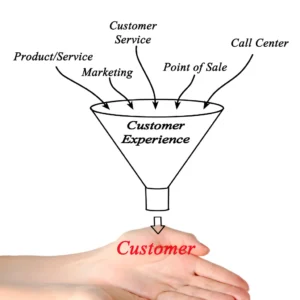
Revolutionizing Retail
Unleashing B2C Industry AI Tools for Advanced Analytics and Reporting
This article explores the details of creating and implementing AI Tools for Analytics and Reporting in the retail B2C sector. From real-time sales dashboards to predictive sales forecasting and customer journey analytics, the toolset discussed promises to revolutionize decision-making processes.
In today’s rapidly changing retail industry, incorporating the latest technologies has become essential for companies striving to remain competitive.
However, the journey has its challenges, necessitating a strategic approach to overcome complexities in data integration, machine learning model accuracy, and staff training.
As we explore the technical nuances, cost considerations, and transformative benefits, it becomes evident that these AI tools are not merely technological enhancements but catalysts for ushering businesses into an era of data-driven success in the competitive retail realm.
Table of Contents

Arindam Roy
An Automation Consultant with 25+ years of IT Experience
AI Tool ideas for Analytics and Reporting
Real-Time Sales Dashboards:
- Data Integration:
- Connect seamlessly with sales and transaction systems to pull real-time data.
- Ensure compatibility with various data formats and APIs.
- Real-Time Data Streaming:
- Implement a robust real-time data streaming mechanism for instant updates.
- Support for popular streaming platforms like Apache Kafka or Amazon Kinesis.
- Customizable Dashboards:
- Allow users to personalize dashboards based on their roles and preferences.
- Provide drag-and-drop functionalities for easy customization.
Predictive Sales Forecasting:
- Machine Learning Models:
- Develop accurate machine learning models for sales trend forecasting.
- Utilize algorithms such as time series analysis, regression, and ensemble methods.
- Integration:
- Integrate with historical sales data and external factors (e.g., economic indicators, weather).
- Ensure compatibility with various data storage solutions like databases, data lakes, or cloud storage.
- Scalable Infrastructure:
- Design an infrastructure capable of handling the computational load for forecasting.
- Utilize cloud services for scalability, such as AWS, Azure, or Google Cloud.
Customer Journey Analytics:
- Tracking and Mapping:
- Implement robust tracking mechanisms to capture customer interactions across channels.
- Map customer journeys comprehensively, including marketing, sales, and customer support touchpoints.
- Integration:
- Integrate with marketing automation, CRM, and customer support systems.
- Ensure data privacy and compliance with regulations.
- Visualization Tools:
- Provide powerful visualization tools for in-depth customer journey analysis.
- Support interactive charts, graphs, and heat maps.
Price Elasticity Analysis:
- Machine Learning Models:
- Develop models for assessing price elasticity using regression and optimization techniques.
- Continuously update models with real-time pricing and sales data.
- Integration:
- Integrate with pricing and sales data systems for seamless analysis.
- Allow easy adjustments to pricing strategies based on elasticity insights.
- Analytics Tools:
- Provide tools for interpreting price elasticity insights.
- Offer scenario analysis for different pricing strategies.
Market Basket Analysis:
- Algorithms:
- Implement efficient algorithms for analyzing product associations.
- Utilize techniques like the Apriori algorithm for identifying frequent item sets.
- Integration:
- Integrate with sales and inventory data for accurate analysis.
- Provide APIs for seamless communication with inventory management systems.
- Recommendations:
- Offer recommendations for optimizing store layouts based on market basket analysis.
- Enable A/B testing for layout changes to measure their impact.
Business Knowledge Requirements
Retail Business Operations Understanding:
- Sales and Transaction Processes: A solid grasp of how sales transactions occur in a retail setting is essential. This includes knowledge of point-of-sale systems, payment processes, and order fulfilment workflows.
- Inventory Management: Understanding how products move through the supply chain, tracking stock levels, and managing inventory turnover rates is crucial for accurate analytics.
- Customer Journey: In-depth knowledge of the customer journey from awareness to purchase, including touchpoints with marketing, sales, and customer support, is vital for effective analytics and reporting.
Pricing and Sales Strategy:
- Pricing Strategies: Familiarity with different pricing strategies employed in retail, such as dynamic pricing, discounting, and bundling, is necessary. This knowledge aids in developing accurate price elasticity models.
- Sales Tactics: Understanding the various sales tactics employed by retailers to drive revenue, including promotions, loyalty programs, and cross-selling, is crucial for interpreting analytics insights.
Marketing Insights:
- Marketing Channels: Knowledge of the diverse marketing channels used in retail, including online platforms, social media, and traditional advertising, is essential for mapping customer journeys and integrating data sources.
- Campaign Performance: Understanding the planning, execution, and measurement of marketing campaigns is vital to designing analytics tools that track the impact of marketing efforts on sales.
Customer Behavior Understanding:
- Consumer Preferences: Knowing the preferences and behaviours of the target customer base helps create personalized dashboards and recommendation systems.
- Customer Satisfaction: Understanding factors contributing to customer satisfaction and loyalty is critical for designing effective customer journey analytics and reporting.
Regulatory Compliance:
- Data Privacy and Security: Understanding data privacy and security regulations is crucial for AI tools in the retail industry to comply with legal requirements and industry standards.
Industry Trends and Competitor Analysis:
- Market Dynamics: Staying informed about industry trends, market dynamics, and emerging technologies is essential for building AI tools that remain relevant and competitive.
- Competitor Analysis: Understanding competitors’ strategies and tools helps identify opportunities for improvement and innovation.
Technical Knowledge Requirements
Programming Languages and Frameworks:
- Backend Development: Proficiency in languages like Python, Java, or Node.js is essential for building the backend infrastructure. Python is valuable for implementing machine learning models due to its rich ecosystem of data science libraries such as Pandas, NumPy, and Scikit-learn.
- Frontend Development: Knowledge of frontend technologies like HTML, CSS, and JavaScript is vital for creating customizable and intuitive dashboards. Frameworks such as React or Angular are ideal for creating dynamic and interactive user interfaces.
- Database Management: A firm grasp of relational databases (e.g., MySQL, PostgreSQL) and NoSQL databases (e.g., MongoDB, Cassandra) is necessary for handling diverse data types and ensuring efficient data retrieval.
Real-Time Data Streaming:
- Apache Kafka or Amazon Kinesis: Understanding and implementing real-time data streaming capabilities require familiarity with tools like Apache Kafka or Amazon Kinesis. These platforms facilitate the seamless data flow from sales and transaction systems to real-time analytics tools.
Machine Learning and Predictive Analysis:
- Data Science Libraries: Proficiency in using data science libraries such as Scikit-learn and TensorFlow is crucial for developing machine learning models. These libraries provide pre-built algorithms and tools for predictive sales forecasting and price elasticity analysis.
- Algorithmic Expertise: Achieving accurate predictive models requires a deep understanding of time series analysis, regression models, and ensemble methods. Knowledge of algorithms like Apriori is beneficial for market basket analysis.
- Cloud Services: Leveraging cloud platforms like AWS, Azure, or Google Cloud is essential for scalable infrastructure to handle the computational load in forecasting computations.
Integration with External Systems:
- APIs and Web Services: A solid grasp of integrating with external systems through APIs and web services is necessary for seamless communication with sales, marketing, and customer support systems. This ensures that the AI tools can access and analyze data from various sources.
Visualization Tools:
- Data Visualization Libraries: Proficiency in data visualization libraries like D3.js, Plotly, or Matplotlib is vital for creating compelling visualizations. These tools enhance customer journey analytics by providing interactive charts, graphs, and heat maps.
- Dashboarding Platforms: Familiarity with dashboarding platforms like Tableau or Power BI is beneficial for creating customizable dashboards that cater to different user roles.
Security and Compliance:
- Data Encryption: It is essential to know data encryption techniques to secure sensitive customer information. This helps to safeguard against unauthorized access and protect against potential data breaches. Implementing encryption protocols during data transmission and storage is essential.
- Regulatory Compliance: A strong understanding of data privacy regulations, such as GDPR or HIPAA, is crucial to ensure that the AI tools adhere to legal requirements and industry standards.
Device Considerations:
- Responsive Design: Implementing responsive design principles ensures that the AI tools are accessible and user-friendly across various devices, including desktops, tablets, and smartphones.
- Cross-Browser Compatibility: Ensuring compatibility with different web browsers guarantees a consistent user experience, allowing stakeholders to access analytics and reports without technical hindrances.
Current AI Tools and Technologies available for Analytics and Reporting
Real-Time Data Streaming:
- Apache Kafka: A distributed streaming platform that excels in handling real-time data feeds. Kafka ensures reliable, scalable, and fault-tolerant data streaming, making it an ideal choice for integrating with real-time sales and transaction systems.
- Amazon Kinesis: As part of the AWS ecosystem, Amazon Kinesis provides a suite of services for real-time data streaming. It allows developers to ingest, process, and analyze streaming data, seamlessly integrating with other AWS services for comprehensive analytics.
Machine Learning and Predictive Analysis:
- Scikit-learn and TensorFlow: Scikit-learn, a machine learning library in Python, offers a wide array of tools for predictive analysis, including regression models. TensorFlow is an open-source framework used to build and deploy machine learning models at scale, essential for predictive sales forecasting.
- AutoML Platforms: Developing machine learning models is now simplified by Automated Machine Learning platforms like Google AutoML or DataRobot. These platforms enable businesses with less technical expertise to leverage advanced predictive analytics capabilities.
- Cloud Machine Learning Services: Cloud providers such as AWS SageMaker, Azure Machine Learning, and Google Cloud AI Platform offer fully managed services for building, training, and deploying machine learning models. These services simplify infrastructure management and enhance scalability for predictive analytics.
Visualization Tools:
- Tableau and Power BI: Tableau and Power BI are dominant players in the data visualization space. These tools provide intuitive dashboarding capabilities, enabling the creation of customizable dashboards for different user roles. They support interactive charts, graphs, and real-time data visualization.
- D3.js: Developers can leverage D3.js, a JavaScript library, to create interactive visualizations with dynamic elements using a data-driven approach. It provides flexibility in designing unique visualizations tailored to specific requirements.
Data Integration and APIs:
- Apache Nifi: An open-source tool for integrating data, enabling data flow automation between different systems. Apache Nifi simplifies integration, allowing seamless communication with external systems through APIs.
- RESTful APIs: REST APIs are commonly used to integrate AI tools with external systems. They enable smooth data exchange between platforms, ensuring the interoperability of sales, marketing, and customer support systems.
Cloud Services:
- AWS, Azure, and Google Cloud: Leading cloud service providers offer many services essential for Retail B2C AI tools. These include scalable infrastructure for forecasting computations, storage solutions for historical sales data, and serverless computing for cost-effective and efficient processing.
Technical Integrations Requirements for AI Tools for Analytics and Reporting
ERP and CRM Systems Integration:
- Data Flow Synchronization: Integrate with Enterprise Resource Planning (ERP) systems to synchronize inventory, sales, and financial data. CRM integration ensures a unified view of customer interactions, allowing for enhanced customer journey analytics.
- Unified Dashboarding: Connect the AI tools with CRM platforms like Salesforce or ERP systems like SAP to create unified dashboards. This integration enables a comprehensive overview, linking customer data with sales and inventory metrics for more informed decision-making.
Marketing Automation Integration:
- Customer Journey Mapping: Integrate with marketing automation tools such as HubSpot or Marketo to map customer journeys comprehensively. This integration facilitates tracking customer interactions from initial engagement through the entire sales funnel.
- Campaign Performance Analysis: Connect with marketing platforms to analyze the performance of campaigns in real time. This integration enables a more comprehensive evaluation of how marketing efforts impact sales and customer behaviour.
Point-of-Sale (POS) Systems Integration:
- Real-Time Sales Data: Integrate with POS systems to capture real-time sales data. This ensures that the AI tools receive immediate transaction updates, enabling the creation of accurate and up-to-date sales dashboards.
- Inventory Management: Sync with inventory management systems linked to POS systems for a consolidated view of stock levels and product movements. This integration helps in optimizing inventory and aligning it with sales trends.
Pricing and Promotion Systems Integration:
- Dynamic Pricing: Connect with pricing systems to implement dynamic pricing strategies based on machine learning insights. This integration allows for real-time adjustments to pricing strategies, considering factors such as competitor pricing and market trends.
- Promotion Tracking: Integrate with promotion systems to track the impact of promotional activities on sales. This integration helps in evaluating the effectiveness of different promotional campaigns.
E-commerce Platform Integration:
- Online Sales Data Integration: For retailers with an online presence, integrating with e-commerce platforms like Shopify or Magento is essential. This integration ensures that the AI tools capture and analyze online sales data along with data from brick-and-mortar stores.
- Multi-Channel Analytics: Provide a seamless experience by integrating data from both online and offline channels. This integration allows for a thorough comprehension of customer behaviour across multiple touchpoints.
Data Security and Compliance Integration:
- Encryption and Authentication: Integrate robust security measures to ensure data encryption during transmission and storage. Implement authentication mechanisms to control access to sensitive customer data.
- Compliance Checks: Ensure compliance with data protection regulations like GDPR or industry standards. Regularly update the AI tools to accommodate any changes in compliance requirements.
Continuous Monitoring and Updates:
- Monitoring Tools Integration: Integrate with monitoring tools like Prometheus or Grafana to continuously monitor the performance of AI tools. Early detection of issues and proactive maintenance are ensured through this process.
- Automated Updates: Implement automated update mechanisms to ensure that the AI tools stay current with the latest algorithms, security patches, and feature enhancements. Regular updates are crucial for maintaining accuracy and relevance in analytics and reporting.
Training Needs for Staff Managing on AI Tools for Analytics and Reporting
Understanding the Purpose and Benefits:
- Clear Objectives: Provide staff with a comprehensive understanding of the purpose and goals of implementing AI tools. This includes elucidating how these tools contribute to improved decision-making, customer satisfaction, and overall business success.
- Benefits Communication: Communicate the benefits these tools bring, such as real-time insights, predictive analytics, and streamlined reporting. This helps staff appreciate the tools’ positive impact on their daily tasks and overall organizational performance.
User-Friendly Interface Navigation:
- Dashboard Navigation: Conduct training sessions on navigating user-friendly interfaces and customizing dashboards. This ensures that staff can easily access the information relevant to their roles without feeling overwhelmed by technical complexities.
- Interactivity: Familiarize staff with interactive features like drag-and-drop functionalities and filtering options. This empowers them to tailor their experience and extract meaningful insights without requiring advanced technical skills.
Interpretation of Analytics Insights:
- Practical Examples: Use practical examples to illustrate how to interpret analytics insights derived from the AI tools. This includes understanding sales trends, customer behaviour patterns, and the implications of predictive forecasting.
- Scenario-Based Training: Implement scenario-based training sessions where staff can apply analytics insights to solve real-world business challenges. The hands-on approach assists in narrowing the gap between theoretical knowledge and practical application.
Collaborative Workshops and Team Training:
- Cross-Departmental Collaboration: Organize workshops encouraging collaboration between different departments, emphasizing how AI tools foster a unified approach to decision-making. This collaborative training ensures that insights from one department can benefit others.
- Team-Based Learning: Facilitate team-based learning sessions to encourage knowledge sharing and peer support. This approach enhances individual learning and promotes a culture of continuous improvement within the organization.
Change Management and Adaptability:
- Change Management Training: Address the fear of change by incorporating change management training. Help staff understand the positive impact of AI tools on their roles, emphasizing that these tools are designed to enhance, not replace, human capabilities.
- Adaptability Skills: Foster adaptability by instilling a growth mindset. Encourage staff to view AI tools as tools that complement their skills and provide resources to develop adaptability skills, allowing them to embrace new technologies confidently.
Ethical Considerations and Data Privacy:
- Ethical Use: Educate staff on the ethical considerations of AI tools, emphasizing the responsible use of customer data and analytics insights. Promote a culture of integrity and compliance with data protection regulations.
- Data Privacy Awareness: Provide training on data privacy principles and safeguarding customer information. This is particularly crucial given the sensitive nature of retail customer data.
Continuous Learning Opportunities:
- Regular Updates: Establish a framework for continuous learning, with regular updates on new features, industry trends, and best practices related to AI tools. This ensures that staff remains informed and can leverage the tools’ evolving capabilities.
- User Community Engagement: Encourage participation in user communities, both internal and external, where staff can share experiences, ask questions, and stay abreast of emerging practices. This collaborative learning approach fosters a sense of community and shared knowledge.
Challenges and Workarounds on AI Tools for Analytics and Reporting
Data Integration Complexity:
- Challenge: Integrating data from various sources, such as sales systems, marketing platforms, and inventory management, can pose challenges due to data format differences and structures.
- Workaround: Implement a robust Extract, Transform, Load (ETL) process to standardize and harmonize data from various sources. Utilize data integration platforms like Apache Nifi to automate and streamline the integration process, ensuring consistent and accurate data across the analytics tools.
Scalability for Real-Time Streaming:
- Challenge: Scaling infrastructure to handle real-time data streaming, especially during peak periods, poses resource allocation and performance challenges.
- Workaround: Leverage cloud-based solutions such as Amazon Kinesis or Apache Kafka to dynamically scale resources based on demand. Employ autoscaling configurations to adjust computing resources automatically, ensuring the system handles varying workloads efficiently.
Machine Learning Model Accuracy:
- Challenge: Achieving high accuracy in machine learning models for predictive sales forecasting and price elasticity analysis can be challenging due to evolving market dynamics.
- Workaround: Implement a continuous learning approach by regularly updating machine learning models with new data. Incorporate feedback loops to capture real-world performance and adjust algorithms accordingly. Utilize automated machine learning (AutoML) platforms to refine models iteratively based on changing patterns.
Usability and Adoption:
- Challenge: Ensuring user-friendly interfaces and fostering user adoption among non-technical staff can be challenging.
- Workaround: Conduct extensive user training programs focusing on intuitive dashboard navigation. Utilize visualization tools like Tableau or Power BI that offer drag-and-drop functionality and allow for customization. Foster a user-centric design approach, incorporating end-user feedback to enhance usability continually.
Privacy and Compliance Concerns:
- Challenge: Adhering to data privacy regulations and ensuring the ethical use of customer data poses challenges in a retail environment where sensitive information is involved.
- Workaround: Implement robust encryption mechanisms to secure data during transmission and storage. Integrate compliance checks within the AI tools to monitor and ensure adherence to privacy regulations. Foster a culture of ethical data use through ongoing training and awareness programs.
System Integration Issues:
- Challenge: Integrating AI tools with existing systems such as ERP, CRM, and marketing automation platforms may encounter compatibility issues.
- Workaround: Utilize standardized APIs and web services to facilitate seamless system communication. Prioritize compatibility during the tool development phase and conduct thorough testing during integration to identify and address potential issues.
Continuous Maintenance and Updates:
- Challenge: Maintaining AI tools and keeping them up-to-date with the latest algorithms and features requires ongoing effort.
- Workaround: Establish automated update mechanisms that regularly fetch and incorporate the latest updates. Implement version control practices to manage changes systematically. Leverage cloud-based solutions for automatic deployment, ensuring a smooth transition to new versions without disrupting operations.
Cost and Benefits of AI Tools designed for Analytics and Reporting
Initial Development Costs:
- Costs: The initial development of AI Tools for Analytics and Reporting incurs expenses related to hiring skilled developers, acquiring technology licenses, and investing in infrastructure and cloud services. Training staff to use the tools also contributes to upfront costs.
- Benefits: The initial development phase sets the foundation for long-term benefits. Investing in cutting-edge technology and skilled personnel leads to the creation of sophisticated tools capable of providing actionable insights.
Integration and Implementation Costs:
- Costs: Integrating AI tools with existing systems, such as ERP, CRM, and marketing platforms, involves additional costs for ensuring seamless communication and compatibility.
- Benefits: Integration ensures a comprehensive and unified view of retail operations. The streamlined data flow between systems enhances efficiency, providing a consolidated platform for analytics and reporting.
Training and Change Management Costs:
- Costs: Training existing staff to use AI tools and implementing change management programs incurs expenses related to educational resources, workshops, and support services.
- Benefits: The investment in training pays off as staff becomes proficient in leveraging AI tools, leading to increased productivity, better decision-making, and improved overall organizational performance.
Maintenance and Updates Costs:
- Costs: Ongoing maintenance, updates, and potential system upgrades involve continuous expenses related to monitoring, debugging, and ensuring the tools remain current with technological advancements.
- Benefits: Regular maintenance ensures the tools operate at peak performance, minimizing downtime and preventing disruptions. Updates introduce new features, improved algorithms, and enhanced security, contributing to the tools’ longevity and relevance.
Operational Efficiency Benefits:
- Costs: While there are initial costs associated with the development and integration of AI tools, the benefits in terms of operational efficiency, streamlined processes, and reduced manual workload can significantly outweigh these expenses.
- Benefits: AI tools automate complex analytical tasks, enabling faster and more accurate decision-making. Operational efficiency gains contribute to cost savings over time by optimizing resource utilization and minimizing errors.
Enhanced Customer Insights and Engagement:
- Costs: Implementing AI tools may require investments in customer data management and privacy compliance measures to ensure the ethical use of customer information.
- Benefits: By analyzing customer behaviour, preferences, and journey patterns, AI tools contribute to personalized marketing strategies and improved customer engagement. When businesses provide quality products and services to their customers, it can result in higher customer satisfaction and loyalty. This, in turn, can have a positive impact on revenue.
Competitive Advantage and Revenue Growth:
- Costs: Investments in AI technology and tools position the business ahead of the curve, but initial costs are associated with staying technologically competitive.
- Benefits: The ability to predict sales trends, optimize pricing, and understand customer behaviour provides a competitive advantage. This and improved decision-making can lead to revenue growth, customer acquisition, and market share expansion.
Conclusion
In conclusion, the journey of developing and utilizing Retail B2C Industry AI Tools for Analytics and Reporting is a strategic investment that navigates through technical intricacies, staff training, and the interplay of costs and benefits. Businesses can address challenges to enhance decision-making, operational efficiency, and machine-learning model accuracy.
Training existing staff emerges as a pivotal element, emphasizing user-friendly interfaces, interpretation of analytics insights, and fostering a culture of adaptability. Integrating AI tools with existing systems and compliance with privacy regulations ensures a seamless data flow, providing a unified view of retail operations.
While initial costs encompass development, integration, and training, the long-term benefits are profound. Operational efficiency, enhanced customer insights, and a competitive edge contribute to revenue growth and market dominance. The continuous maintenance and updates sustain the relevance and effectiveness of AI tools in the ever-evolving retail landscape.
In business terms, the investment in Retail B2C Industry AI Tools aligns with the industry’s technological demands and positions organizations for sustained success. The ability to predict sales trends, optimize pricing, and understand customer behaviour creates a strategic advantage, fostering innovation and growth.
As businesses navigate this transformative journey, it becomes evident that adopting AI tools goes beyond mere technological upgrades; it signifies a commitment to data-driven decision-making, operational excellence, and a customer-centric approach. Ultimately, the fusion of technology, skilled personnel, and a strategic mindset propels businesses into a future where the seamless integration of AI tools becomes synonymous with success in the competitive and dynamic retail environment.
Related Articles
- AI Automation Tools in Brick-and-Mortar Retail Store
- AI Tools for Retail B2C Industry
- AI Tools for Customer Feedback and Support in Retail B2C
- AI Tools for Marketing and Advertising in Retail B2C Industry
- AI Tools for Fraud Prevention and Security in Retail B2C
- AI Tools for Sales and Conversion Optimization in the Retail B2C
- AI Tools for Customer Loyalty and Retention in Retail B2C
- AI Tools for Product Management and Innovation in Retail
- AI Tools for Supply Chain Visibility and Optimization in Retail
- AI Tools for Customer Experience and Engagement in Retail
- AI Tools for Inventory and Supply Chain Management for Retail
- AI in Retail Customer Experience























